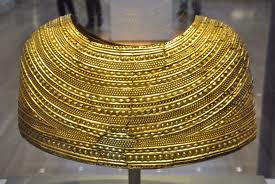The Golden Ghost of Mold #1: Introducing the Golden Ghost August 12, 2013
Author: Beach Combing | in : Modern, Prehistoric , trackbackThere follows a ghost story. It is brief and it is archaeological. If M.R.James had heard of this one he would have made bales of ectoplasmic hay.
We are in North-West Wales. A certain John Langford had bought some land at Mold near Wrexham and had decided to fill in a hole there by paying a dozen workmen to push a bank down: he was presumably thinking of ploughing up the land. While digging the workmen found various large stones that, it transpired, were part of an early tomb and in its centre a corselet, some bones, a bronze knife and lots of beads. This corselet was, experts discovered, made of gold and it was given to the British museum and became the famous Mold cape, a prehistoric golden poncho. The following letter comes from the Reverend Clough who was in the parish at time of discovery.
Connected with this subject, it is certainly a strange circumstance that an elderly woman, who had been to Mold to lead her husband home late at night from a public house, should have seen or fancied, a spectre to have crossed the road before her to the identical mound of grave, ‘of unusual size, and clothed in a coat of gold, which shone like the sun,’ and that she should tell the story in the next morning many years ago, amongst others to the very person, Mr John Langford, whose workmen drew the treasure out of its prison-house. Her having related this story is an undoubted fact. I cannot, however, learn that the there was any tradition of such an internment having taken place; though possibly this old woman might have heard of something of the kind in her youth, which still dwelt upon her memory, and associated with the common appellation of the Bank ‘Bryn-yr Ellyllon’, (the Fairies’ or Goblins’ Hill) and a very general idea that the place was haunted, presented the gold effigy to imagination.
Three comments on this. First, for all those who take this as the final proof that ghosts do exist, a golden woman (another post another day) rather than a golden man would have been truer to the tomb as they entombed seems not to have been a man. Second, fairies don’t to our knowledge, even in Wales wear gold, though they are sometimes associated with golden light. Third, note the topos of the public house, so common in fairy accounts with tiresome puns on spirits and spirit, though in an unusual twist the witness had not drunk there, it was her husband who was zigzagging down the road. Any other thoughts on the golden ghost: drbeachcombing AT yahoo DOT com



